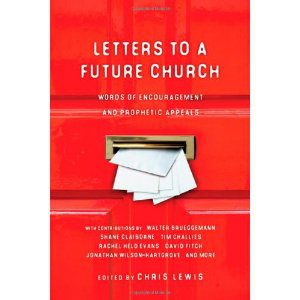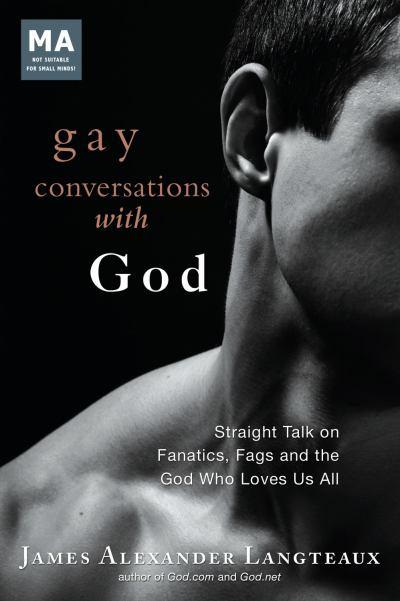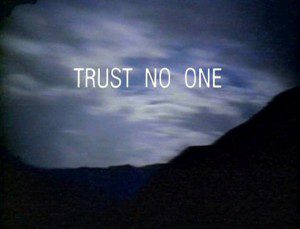Letters to a Future Church is a pithy, lively little book. It features more than two dozen contributors crammed into 164 breezy pages.
 The book, edited by Chris Lewis, comes out of a 2010 conference in Toronto for which speakers were asked to compose short letters to the church, modeled after the seven letters to seven churches that open the book of Revelation. The conference got some Big Names on board — people like Walter Brueggemann, Ron Sider, Shane Claiborne, Peter Rollins and Eugene Peterson (and to those outside of the subculture, trust me, those guys are subculturally famous). But they also, intentionally, didn’t allow church celebrities or “gatekeepers” to dominate the conversation. The conference sought out other smart, but less-famous voices (including terrific bloggers like Rachel Held Evans and Kathy Escobar) and put out an open call for letters that resulted in some of the more interesting and inspiring essays collected here.
The book, edited by Chris Lewis, comes out of a 2010 conference in Toronto for which speakers were asked to compose short letters to the church, modeled after the seven letters to seven churches that open the book of Revelation. The conference got some Big Names on board — people like Walter Brueggemann, Ron Sider, Shane Claiborne, Peter Rollins and Eugene Peterson (and to those outside of the subculture, trust me, those guys are subculturally famous). But they also, intentionally, didn’t allow church celebrities or “gatekeepers” to dominate the conversation. The conference sought out other smart, but less-famous voices (including terrific bloggers like Rachel Held Evans and Kathy Escobar) and put out an open call for letters that resulted in some of the more interesting and inspiring essays collected here.
The format of these essays gives the collection a sense of urgency. Contributors were given wide latitude on their choice of subject, but were also forced to keep it short. That combination of sweeping ambition and brevity focuses these essays into something like “Here is what I have to say that is most important to me,” and that asks for, and often rewards, our attention.
Because of that brevity, one can readily re-read the essays here that invite further reflection — and many of these do. (And in the case of the handful of clunkers here, that brevity means you’re done with them almost soon enough.)
There are big dreams here, words of gratitude and of criticism, arguments, condemnations, manifestos, visions, agendas, parables, pedantry, poetry and prophecy. There are personal testimonies that challenge and inspire. There are some heartfelt pleas for what we need to change, and a few harrumphing sermons on what you people need to change.
Basically, you’re getting to meet a couple dozen people who are trying, in just a few pages, to tell you who they are and who they want to be as honestly as they can. If you find people interesting, there are plenty of them here.
Tony Jones wrote about Letters to a Future Church yesterday and he makes several points I’d second here. He commends Pete Rollins’ letter (from which I gleaned this joke/parable) and pans the lecturing essay by Tim Challies (which I wrote about earlier in “Healing and the justice of God“) and praises the concise wisdom of James Shelley’s one-point-and-done entry reminding Christians that the Bible doesn’t say anything without our interpreting it.
Tony also reacts to what was, for me, an initial source of great disappointment. He writes:
These aren’t letters to a future church, as the book’s title promises. They are letters to the church today. Actually, I’d be very intrigued by a book of letters to the church 100 or 1,000 years from now. But that’s not this book.
That’s what I was hoping this title promised — a book of letters to the church of 2112. Or, better yet, a book of letters from the church of 2112. What will Christians 100 years from now have to say to us?
I don’t imagine they’ll be terribly impressed with the way we’re still restricting and debating the role of women in the church. I would imagine, actually, that that very phrase — “the role of women in the church” — with all of its assumptions and condescensions, will be viewed a hundred years from now as an embarrassing artifact of our current failings.
Nor do I suspect that our future heirs in the church will be terribly impressed that it has taken us so long to make so little progress lurching and staggering toward the full and equal participation of LGBT believers, or toward overcoming the racial and ethnic and class barriers we have constructed throughout our churches.
The theme of a great many “Letters From a Future Church,” I think, would be “Just what part of Galatians 3:28 didn’t you people understand?”
I also can’t imagine the church of 2112 looking back on us with fond gratitude for what we’re doing and allowing to be done to the climate they will have to endure living in. For example, today in 2012 there is a Christian minority in the officially Muslim nation of the Maldives, but we know that by 2112 there won’t be any Christians living there at all. Or Muslims either. Because, thanks to our actions and inactions, by 2112 the Maldives will likely no longer exist.
What’s most interesting to me about the church of the future isn’t the ways in which it will be different, but rather the ways in which it will be the same. “Love God and love your neighbor” will still be the core of the faith, even when taught by the chaplain for the work crew of an orbiting Planetary Resources station overseeing the robotic mining vessels busily dismantling Mercury for the construction of the Dyson sphere.
But, as Tony said, “that’s not this book.”
This book is about the church today — mostly the North American church. It is a book of its time.
Yet think about the apologetic way that phrase is often employed — “Well, you have to understand, he was a man of his time.” Keeping an eye to the future — trying to imagine how our time will be viewed by generations yet to come — turns out to be a necessary aspect to understanding the present.
Letters to a Future Church is not really one addressed to those future generations. But if some member of the church of 2112 should somehow stumble across a copy, I think they would find a compelling, intriguing snapshot from the church of 2012, as well as a few timely expressions of timeless ideas.












